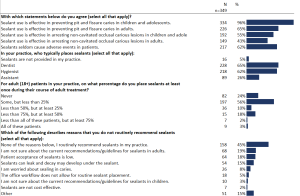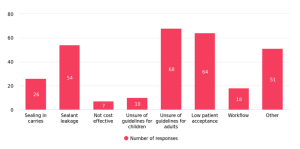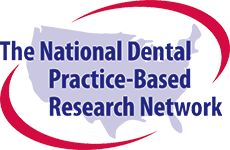Our latest Quick Poll results Participants shows Network dentists are driven by their dedication to improving patient care and keeping up with the latest clinical advancements. However, they face challenges such as time constraints and difficulties with patient recruitment.
Exploring dental sealant use: A Network survey on attitudes, practices, and barriers among dental practitioners

Dental Sealant Use in Adults and Children: Preliminary Qualitative Findings
Authors: Daryl Konstandt, Michelle Henshaw, Eric Bolter, and Joana Cunha-Cruz
Introduction
The use of dental sealants has been shown to be low, despite evidence that dental sealants are safe, effective, and inexpensive (Wright et al., 2016, Polk et al., 2018; Lang et al., 1991). Therefore, we conducted a 4-question Quick Poll to explore dental providers’ behavior and attitudes regarding dental sealant use. Through this Quick Poll, we sought to understand the barriers to sealant use in dental practices.
Methods
Study Design and Participants:
This is a cross-sectional survey with dental practitioners, members of the National Dental Practice-Based Research Network in the United States.
Data collection:
Members of the network were invited to participate in an online survey through email and social media channels. Two email invitations were sent to all members: one in the network’s monthly newsletter sent on April 5, 2023, and one as a follow-up email sent on April 14, 2023. The Quick Poll was announced on the network’s social media accounts (Facebook and Instagram). The Quick Poll was open from April 5 until May 5, 2023. The page was opened 1,055 times and the survey was completed 349 times.
Measures and Data Analysis:
The survey content included four questions [Table 1]. We asked dental practitioners whether they use sealants in their dental practices and which staff typically place sealants. Practitioners were also asked whether they believed dental sealants were effective in the following: (1) preventing pit and fissure caries in children and adolescents, (2) preventing pit and fissure caries in adults, (3) arresting non-cavitated occlusal carious lesions in children and adolescents, and (4) arresting non-cavitated occlusal carious lesions in adults. Additionally, we asked practitioners whether they agreed that sealants seldom cause adverse events in patients. Finally, we inquired about the percentage of patients in their practice who have received dental sealants as adults.
The data were collected through a web survey in Constant Contact, a digital and email marketing platform. Data were analyzed using descriptive statistics.
Results
Almost all of the respondents (95%) reported that their practices provide dental sealants, and 45% reported that they routinely recommend sealants to their patients. Of the practitioners who reported that they did not routinely recommend sealants, the most common barriers were uncertainty about recommendations/guidelines for sealants in adults (36%), low patient acceptance (34%) and potential sealant leakage (28%). In the practices offering sealants, sealant placement was typically provided by dentists (65%) and hygienists (62%), with fewer practices utilizing dental assistants (26%).
Nearly all dental practitioners (96%) agreed that sealants are effective in preventing pit and fissure caries in children and adolescents, compared with 65% who agreed they were effective in adults. Eighty percent of practitioners reported that they place sealants on less than 25% of their adult patients during some part of the course of their treatment. Far fewer dentists agreed that sealants were effective in arresting non-cavitated occlusal caries in children (55%) and adults (43%). Only 62% of dentists agreed that sealants seldom caused adverse events in patients.
Conclusions
Most practitioners agree that dental sealants are effective in preventing occlusal caries in children and adolescents. However, only about one-half of respondents agreed that sealants could be used to arrest non-cavitated caries occlusal lesions in both adults and children. Moreover, over half of practitioners surveyed did not routinely recommend sealants. The primary reasons for lack of sealant use are: (1) uncertainty about guidelines for adult sealants, (2) low patient acceptance, and (3) concern about sealant leakage.
Highlights
- Respondents’ agreement regarding the sealants’ effectiveness in preventing pit and fissure caries varied by patient age, with 96% of respondents agreeing sealants are effective in children, compared to 65% agreeing sealants are effective in adults.
- Over half of respondents (55%) do not routinely recommend sealants to their patients.
- The primary reasons for not using dental sealants are uncertainty about adult sealant guidelines, low patient acceptance and concerns with sealant leakage.
Table 1. Perceptions of dental practitioners related to the use of sealants when treating dental patients: National Dental Practice-Based Research, 2023.

Figure 1. Reasons that dental practitioners do not recommend dental sealants to patients (of the practitioners who reported that they do not routinely recommend sealants).

This Quick Poll was presented as a poster at the 2024 AADOCR by Daryl Konstandt.
References
Lang WP, Farghaly MM, Woolfolk MW, Ziemiecki TL, Faja BW. Educating dentists about fissure sealants: effects on knowledge, attitudes, and use. J Public Health Dent. 1991 Summer;51(3):164-9. doi: 10.1111/j.1752-7325.1991.tb02208.x. PMID: 1920269.
Polk DE, Weyant RJ, Shah NH, Fellows JL, Pihlstrom DJ, Frantsve-Hawley J. Barriers to sealant guideline implementation within a multi-site managed care dental practice. BMC Oral Health. 2018 Feb 2;18(1):17. doi: 10.1186/s12903-018-0480-z. PMID: 29394921; PMCID: PMC5797385.
Wright JT, Crall JJ, Fontana M, Gillette EJ, Nový BB, Dhar V, Donly K, Hewlett ER, Quinonez RB, Chaffin J, Crespin M, Iafolla T, Siegal MD, Tampi MP, Graham L, Estrich C, Carrasco-Labra A. Evidence-based clinical practice guideline for the use of pit-and-fissure sealants: A report of the American Dental Association and the American Academy of Pediatric Dentistry. J Am Dent Assoc. 2016 Aug;147(8):672-682.e12. doi: 10.1016/j.adaj.2016.06.001. PMID: 27470525.
Interested in Becoming a Member?




